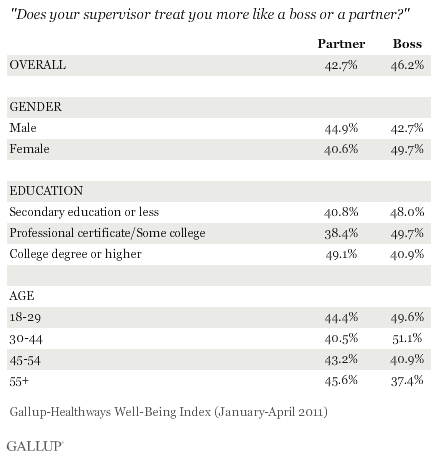WASHINGTON, D.C. -- British men and those in the United Kingdom with a college degree are among the most likely in their country to report being employed in a good work environment, according to the Gallup-Healthways Well-Being Index. Women, workers aged 30 to 44, and those with less education rate their work environments less positively.

Of British employees surveyed, 36.6% reported good work environments in the January-April 2011 Gallup-Healthways Well-Being Index tracking.
���۴�ýand Healthways determine workplace quality using the Work Environment Index, which includes four items that measure British workers' job satisfaction, their ability to use their strengths at work every day, their relationship with their supervisor, and whether their supervisor creates a trusting and open work environment. Those who respond positively to all four metrics are considered to have a good work environment. Those who do not do so are in a subpar workplace.
Women, Younger Britons, and the Less Educated Struggle With Supervisor Relationship
Women, younger workers, and those without a college degree lag behind on one key work environment metric in particular: They are more likely to say their supervisor treats them more like a boss than a partner. About half of respondents in each of those groups say this compared with less than half of men (42.7%), those with a college degree (40.9%), and older Britons.

Men and older workers' advantages in their supervisor relationships hold even after controlling for one's education level.
The employee-supervisor relationship is the area where . Out of all four work environment measures, it is also the item in which differences by gender, age, and education are greatest in the U.K.
Implications
The Gallup-Healthways Well-Being Index findings suggest that efforts to improve employee-supervisor relationships in U.K. workplaces -- especially for women, those with less education, and 30- to 44-year-olds -- could go a long way toward increasing workplace well-being. In general, Britons are more likely than Americans to report workplaces that reflect a more traditional, hierarchy-based structure found in boss-subordinate relationships. That these perceptions are even more pronounced within certain groups gives leaders tangible evidence to act toward a more equitable environment of partnership.
all Gallup-Healthways Well-Being Index questions and methodology
About the Gallup-Healthways Well-Being Index
The Gallup-Healthways Well-Being Index tracks U.K. and U.S. well-being and provides best-in-class solutions for a healthier world. To learn more, please visit .
For complete data sets or custom research from the more than 150 countries ���۴�ýcontinually surveys, please contact SocialandEconomicAnalysis@gallup.com or call 202.715.3030.
Survey Methods
Results are based on telephone interviews conducted as part of the Gallup-Healthways Well-Being Index survey Jan. 2-April 30, 2011, with a random sample of 2,118 adults, aged 18 and older, living in the United Kingdom, selected using random-digit-dial sampling.
For results based on the total sample of national adults, one can say with 95% confidence that the maximum margin of sampling error is ±2.2 percentage points.
Interviews are conducted with respondents on landline telephones and cellular phones. Each daily sample includes a minimum quota of 5 cell phone respondents and 29 landline respondents, with additional minimum quotas among landline respondents for gender within the region. Landline respondents are chosen at random within each household on the basis of which member had the most recent birthday.
Samples are weighted by gender, age, education, region, adults in the household, cell phone status. Demographic weighting targets are based on the most recently published population data from the Census Bureau for Northern Ireland, Scotland, England, and Wales. All reported margins of sampling error include the computed design effects for weighting and sample design.
In addition to sampling error, question wording and practical difficulties in conducting surveys can introduce error or bias into the findings of public opinion polls.
For more details on Gallup's polling methodology, visit .
